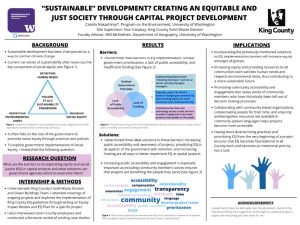“Sustainable” Development? Creating an Equitable and Just Society Through Capital Project Development
Sustainability and sustainable development have been promoted in recent years as ways to combat climate change and support communities. However, these disciplines often ignore social equity, which is a key component of many sustainability frameworks. Social equity must be incorporated in sustainable projects to ensure an equitable and just future across all communities. The purpose of this research was to determine best ways of incorporating equity and social justice (ESJ) in capital projects. To accomplish this, I interned with King County’s Solid Waste Division and attended meetings of ongoing capital projects, wrote an equity impact review and equity and social justice strategic plan for a specific project, and conducted interviews with county employees. Additionally, I conducted a literature review of existing case studies around the world. I compiled the data and information I gathered to answer my research question. My findings revealed that a lack of funding, unclear government priorities, and deterrents to community accessibility are the three main barriers to effective ESJ implementation. On the other hand, community engagement, public accessibility, and government transparency, are three overarching themes of effective ESJ implementation. By incorporating these into capital projects while avoiding the outlined barriers, projects are able to better serve and benefit the communities they are meant to. The overall health of the community is supported, which is important in creating more equity across all groups and ultimately attaining a sustainable society.
